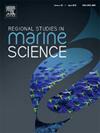Eastern Mediterranean sea turtles in their epipelagic phase: First records of monthly growth rates and effects of a plastic pollutant
IF 2.1
4区 环境科学与生态学
Q3 ECOLOGY
引用次数: 0
Abstract
Most sea turtle conservation efforts worldwide are focused on nesting beaches. After hatchlings reach the sea, however, monitoring, research, and conservation are not prioritized, and little is known about the next life stages, when turtles are passively drifting in pelagic habitats. We study the biology of and threats to hatchling to juvenile loggerhead (Caretta caretta) and green (Chelonia mydas) sea turtle subpopulations in the Mediterranean Sea, using a dataset composed of cases of injured sea turtles that were brought for treatment to Israel's Sea Turtle Rescue Center from 1999–2020. Using length distribution of minimum curved carapace lengths, we calculated for the first time the month-specific growth rates of both turtle species. Loggerhead turtles grew at a rate of 0.76 cm month–1 in the first 19 months of life and green sea turtles grew 0.92 cm month–1 in the first 11 months of life. We also found that a major cause of injury for epipelagic phase turtles, ≤ 40 cm curved carapace length, was entanglement in polypropylene sacks. The proportion of epipelagic phase turtles treated in Israel's Sea Turtle Rescue Center due to these entanglements increased from 20 % of the epipelagic phase cases in 2008–75 % by the last year of this study (2020). We suspect that livestock carriers are the origin of these sacks, and preventing this type of marine pollution is crucial for populations prosperity and requires international collaboration.
求助全文
约1分钟内获得全文
求助全文
来源期刊

Regional Studies in Marine Science
Agricultural and Biological Sciences-Ecology, Evolution, Behavior and Systematics
CiteScore
3.90
自引率
4.80%
发文量
336
审稿时长
69 days
期刊介绍:
REGIONAL STUDIES IN MARINE SCIENCE will publish scientifically sound papers on regional aspects of maritime and marine resources in estuaries, coastal zones, continental shelf, the seas and oceans.
 求助内容:
求助内容: 应助结果提醒方式:
应助结果提醒方式:


